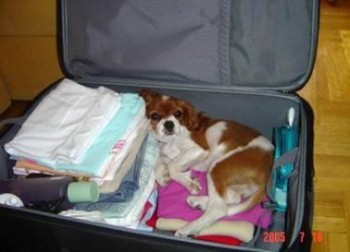 October is Pet Safety & Wellness Month, so all month long, our top ten lists will be devoted to keeping your dog safe. Here’s this week’s list, focusing on evacuations due to fire, flood, hurricane, or other natural disaster:
October is Pet Safety & Wellness Month, so all month long, our top ten lists will be devoted to keeping your dog safe. Here’s this week’s list, focusing on evacuations due to fire, flood, hurricane, or other natural disaster:
10. If you ever have to be evacuated from your home take your dog with you. If you can’t stay, he or she shouldn’t either.
9. Plan ahead for evacuations by knowing which hotels allow animals. If you live in an area where there are hurricanes or other natural disasters, chances are you have an evacuation location already scouted out for yourself. It’s worth a phone call to hotels in that area to find out about their dog policies.
8. Keep in mind that shelters run by the Red Cross allow only service dogs, not pets.
7. If you know you will be unable to take your dog to the place where you will be sheltering, make a list of friends and family members who live outside the flood or hurricane zone who may be willing to care for your dog during an emergency.
6. If you have lots of animals, make plans for them to be housed separately. No one is going to take in all of them, unless you have really, really good friends who are as nuts about animals as you are.
5. If you hold evacuation drills or even fire drills in your home, make sure your dogs are included. It’s going to be stressful enough to get you and your kids organized in the event of a real disaster, and you should be able to rely on your practice drill experience with the dogs to make everything run more smoothly.
4. Make sure your dog’s vaccinations are up to date. Most shelters will not keep an un-vaccinated dog, and if your dog isn’t protected by vaccine, you don’t want him or her in an environment crowded with other dogs.
3. Make sure you have ID tags or a micro-chip on your dog. If he is not with you during an emergency, he may escape from wherever he is to try to find you.
2. Make a “go-bag” for your dog. At a minimum, you should have at least a 3-day supply of food and water, the dog’s vaccine record, and any medication your dog takes regularly.
1. When you get to go home, you will likely face a different situation than you left. Remember to check out any hazards from a lower level than you might look for just yourself. Make sure your dog isn’t stepping in or sniffing around anything he shouldn’t be in.
Stay Safe!
Until next time,
Good day, and good dog!
